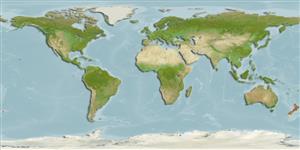>
Gobiesociformes (Clingfishes) >
Gobiesocidae (Clingfishes and singleslits) > Trachelochisminae
Eponymy: Richard ‘Dick’ Kenneth Dell (1920–2002) was Director, Dominion Museum (now Te Papa). [...] John ‘Jock’ Munne Moreland (1921–2012) was Curator of Fishes, Dominion Museum (now Te Papa), Wellington. [...] (Ref. 128868), visit book page.
More on author: Briggs.
Environment: milieu / climate zone / rango de profundidad / distribution range
Ecología
marino demersal; rango de profundidad 0 - 15 m (Ref. 9003). Temperate
Southwest Pacific: endemic to New Zealand.
Tamaño / Peso / Age
Madurez: Lm ? range ? - ? cm
Max length : 8.5 cm TL macho / no sexado; (Ref. 27207)
Short description
Claves de identificación | Morfología | Morfometría
Espinas dorsales (total) : 0; Radios blandos dorsales (total) : 8 - 9; Espinas anales: 0; Radios blandos anales: 8 - 9. Head and body purple or cream with blue spots. A band of pale color across nape. Distinguished from other clingfishes by its thin lips, exposed flap of skin across the snout and a small fleshy swelling at the base of the pectoral fin.
Body shape (shape guide): elongated.
Occurs in rock pools and the subtidal zone. Usually found beneath the spines of sea urchins. Individuals too large to be associated with sea urchins usually found beneath rocks or among shell debris. Feeds mainly on the tube feet and pedicellariae of its host sea urchins, Evechinus chloroticus (Ref. 33548) and on small crustaceans.
Life cycle and mating behavior
Madurez | Reproducción | Puesta | Huevos | Fecundidad | Larva
Paulin, C. and C. Roberts, 1992. The rockpool fishes of New Zealand (Te ika aaria o Aotearoa). Museum of New Zealand (Te Papa Tongarewa). 177 p. (Ref. 9003)
IUCN Red List Status (Ref. 130435: Version 2025-1)
Threat to humans
Harmless
Human uses
Herramientas
Special reports
Download XML
Fuentes de Internet
Estimates based on models
Preferred temperature (Referencia
123201): 12.6 - 18.5, mean 16.2 °C (based on 104 cells).
Phylogenetic diversity index (Referencia
82804): PD
50 = 1.0000 [Uniqueness, from 0.5 = low to 2.0 = high].
Bayesian length-weight: a=0.00457 (0.00179 - 0.01169), b=3.12 (2.89 - 3.35), in cm total length, based on LWR estimates for this (Sub)family-body shape (Ref.
93245).
Nivel trófico (Referencia
69278): 3.0 ±0.1 se; based on diet studies.
Resiliencia (Referencia
120179): Medio, población duplicada en un tiempo mínimo de 1.4-4.4 años (Preliminary K or Fecundity.).
Fishing Vulnerability (Ref.
59153): Low vulnerability (10 of 100).
🛈
Nutrients (Ref.
124155): Calcium = 128 [68, 317] mg/100g; Iron = 0.486 [0.274, 0.973] mg/100g; Protein = 16.9 [15.7, 18.1] %; Omega3 = 0.472 [0.223, 1.003] g/100g; Selenium = 6.28 [2.51, 15.29] μg/100g; VitaminA = 46.3 [10.6, 191.5] μg/100g; Zinc = 1.16 [0.74, 1.75] mg/100g (wet weight);
